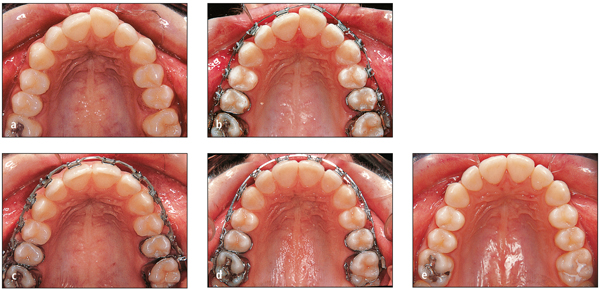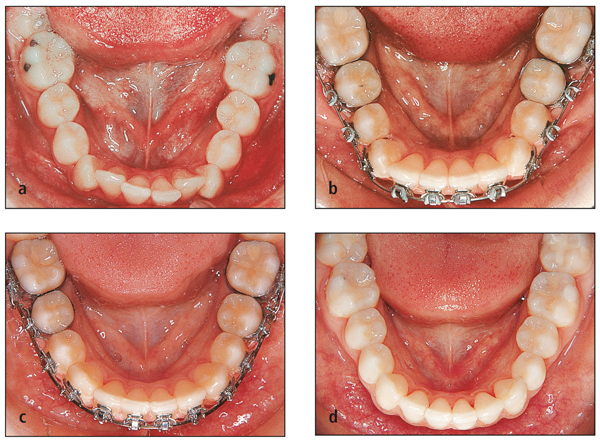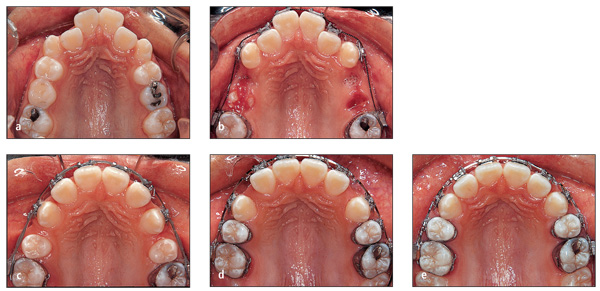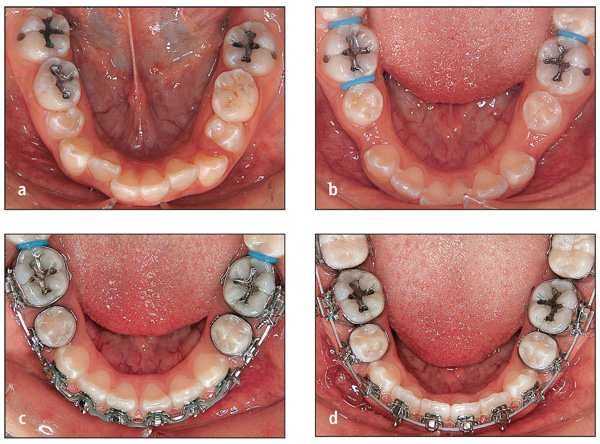
Follow a Logical Archwire Sequence
A review of orthodontic archwires and their forces is found in chapter 8 of my earlier textbook.1 Since that book was written, the only addition to the archwire selection used in my office has been the introduction of heat-activated copper nickel-titanium wire. This new wire technology allows the wire to be deformed a greater amount when “chilled,” so that the wire can be ligated in situations of excessive crowding without a permanent deformation or set. The warmth of the oral environment will cause the wire to return to its original shape, the arch form. Although this archwire is very effective, experience indicates that it will not control torque on mandibular incisors as effectively as does the stainless steel (SS), 8-strand braided wire.
Three goals for archwires are (1) to ensure patient comfort, (2) to maximize the potential of each wire, and (3) to attain the final archwire as soon as possible.
Archwire Types
The very complex subject of archwires can be understood more easily at a basic, clinical level by learning about the four distinct categories they fall into: flexible, transitional, closing, and stiff.
Flexible (initial) archwire
Maxillary arch: inch Triple Flex SS; 0.017 × 0.025-inch NiTi
Mandibular arch: 0.016 × 0.022-inch or 0.017 × 0.025-inch D-Rect/Turbo/copper nickel-titanium (CuNiTi)
Transitional (intermediate) archwire
Maxillary arch: 0.016-inch SS; 0.017 × 0.025-inch titaniummolybdenum alloy (TMA)
Mandibular arch: 0.016 0.022-inch TMA; 0.016 × 0.022-inch TMA; 0.016 inch SS
Closing archwire
Maxillary arch: 0.017 × 0.025-inch SS with closing loops; 0.017 × 0.025-inch T-loops
Mandibular arch: 0.016 × 0.022-inch SS with closing loops
Stiff (finishing) archwire
Maxillary arch: 0.017 × 0.025-inch SS
Mandibular arch: 0.017 × 0.025-inch SS
Archwire Functions
The functions of the archwires, in sequential order, include:
1. Elimination of rotations
2. Development of arch form
3. Leveling of the arches
4. Control of torque
Archwires take time to fully express their potential. The orthodontist must allow the archwires the time necessary to express their full potential before moving on to the next archwire. This is especially true during elimination of rotations with the initial archwire. In principle 13, the importance of allowing the wires to complete their objectives, or “letting them cook,” is discussed. However, for the arch wires to fully express their desired effects, the orthodontist must always ensure that the archwire is fully engaged in the bracket slot. Typical archwire sequencing, its purpose, and its duration are discussed in the following sections (Figs 10-1 to 10-4).
Fig 10-1 (a) Pretreatment maxillary occlusal view. (b) Maxillary initial archwire: 0.016-inch NiTi. (c) Three months. Maxillary second archwire: 0.016-inch SS with power chains. (d) Eight months. Maxillary third archwire: 0.017 × 0.025-inch SS. (e) Three-year posttreatment maxillary occlusal view.
Fig 10-2 (a) Pretreatment mandibular occlusal view. (b) Mandibular initial archwire: 0.016-inch NiTi, interproximal enamel reduction; class 3 elastics. (c) Mandibular finishing archwire: 0.017 × 0.025-inch SS. (d) Threeyear posttreatment mandibular occlusal view.
Fig 10-3 (a) Pretreatment maxillary occlusal view. (b) Maxillary initial archwire: 0.0175-inch multistranded. (c) Four months. Maxillary second archwire: 0.016-inch SS with power chains to retract canines. (d) Eleven months. Maxillary third archwire: 0.017 × 0.025-inch SS closing loops to retract incisors. (e) Fourteen months. Maxillary fourth archwire: 0.017 × 0.025-inch SS finishing.
Fig 10-4 (a) Pretreatment mandibular occlusal view. (b) Five months: driftodontics. (c) Ten months. Second archwire: 0.016 × 0.022-inch SS closing loops. (d) Twelve months. Third archwire: 0.017 × 0.025-inch SS finishing. Second molars banded.
Archwire Sequencing
Nonextraction archwire sequence: Maxillary arch
Initial (Fig 10-1b)
Flexible round (0.0175-inch multistranded SS or 0.016-inch NiTi). These archwires are bent back distal to the molars (“cinched” back). Occasionally, a 0.017 × 0.025-inch copper NiTi archwire is used if initial torque control is an issue.
Purpose. These archwires are used to correct rotations, initiate leveling, and develop arch form.
Duration. 1 to 3 months. The patient is examined at 4- to 6-week intervals to tie any rotations and to ensure that the archwire is fully engaged.
Transitional (Fig 10-1c)
Intermediate (0.016-inch SS and/or 0.017 × 0.025-inch TMA or 0.016 × 0.022-inch SS). Omega loops are placed mesial to the terminal molar band and tied back.
Purpose. These archwires are intended to complete any rotation correction, continue leveling, provide torque control, and develop arch form. If any spaces are present, these are closed with 0.016-inch SS archwire and elastomeric chain, from molar to molar.
Duration. 2 to 4 months at 5- to 6-week intervals.
Finishing (Fig 10-1d)
Stiff rectangular (0.017 × 0.025-inch SS). This wire is always used with omega loops—tied back.
Purpose. This archwire finalizes leveling, torque, and arch form.
Duration. Through the end of treatment. Appointments are scheduled as needed to correct the final occlusion.
Nonextraction archwire sequence: Mandibular arch
In the author’s opinion, controlling the position of the mandibular incisors with the initial archwire is a critical factor for the success of treatment. If torque control is an issue, it must be addressed in the initial archwire.
Initial (Fig 10-2b)
Flexible rectangular (0.016 × 0.022-inch or 0.017 × 0.025-inch CuNiTi, Turbo, or D-Rect). The archwire does not have to be tied or cinched back.
Purpose. The archwire is intended to correct rotations, initiate leveling, and provide initial torque control.
Duration. 1 to 3 months. To control torque in crowded anterior teeth, several options may be considered. The first goal is to achieve good archwire engagement in the brackets. When this is difficult to accomplish, interproximal enamel reduction with a 0.016-inch NiTi may be necessary. Prescribing class 3 elastics for 3 days (72 hours) can also help control the tendency for labial flaring of these anterior teeth. Each of these procedures can be accomplished with the initial archwire. Appointment intervals of 4 to 5 weeks are adequate. Occasionally, after the 0.017 × 0.025-inch CuNiTi, a D-Rect wire may be necessary to complete the correction of any remaining rotations. Therefore, two flexible rectangular archwires may be required.
Transitional
Intermediate (0.016 × 0.022-inch SS or 0.017 × 0.022-inch SS or 0.017 inch TMA). More than one archwire may be required. Omega loops are placed in these archwires and tied back. Reverse curves are formed in these wires for treatment of deep bite.
Purpose. These archwires provide minor rotation correction, continued leveling, arch form development, and torque control.
Duration. 3 to 6 months.
Finishing (Fig 10-2c)
Stiff rectangular (0.017 × 0.025-inch SS). These finishing archwires always have omega loops placed and tied back. The final amount of reverse curve is dependent on the patient’s degree of overbite.
Purpose. These wires are used to finalize leveling, torque, and arch form.
Duration. Through the end of treatment. Appointments are scheduled as needed for correction of the final occlusion. This is a high-stiffness archwire and must therefore be precise in its final form, which will be replicated intraorally.
Extraction archwire sequence: Maxillary arch
Initial (Fig 10-3b)
Flexible round (0.0175-inch multistranded SS or 0.016- inch NiTi). These archwires are cinched back.
Stay updated, free dental videos. Join our Telegram channel

VIDEdental - Online dental courses






